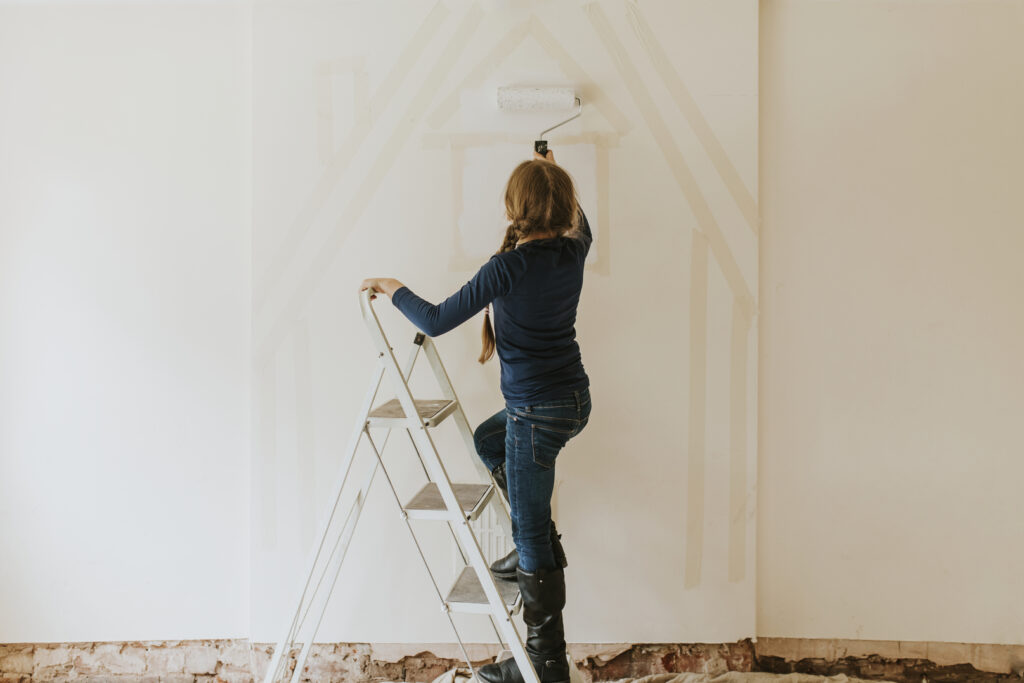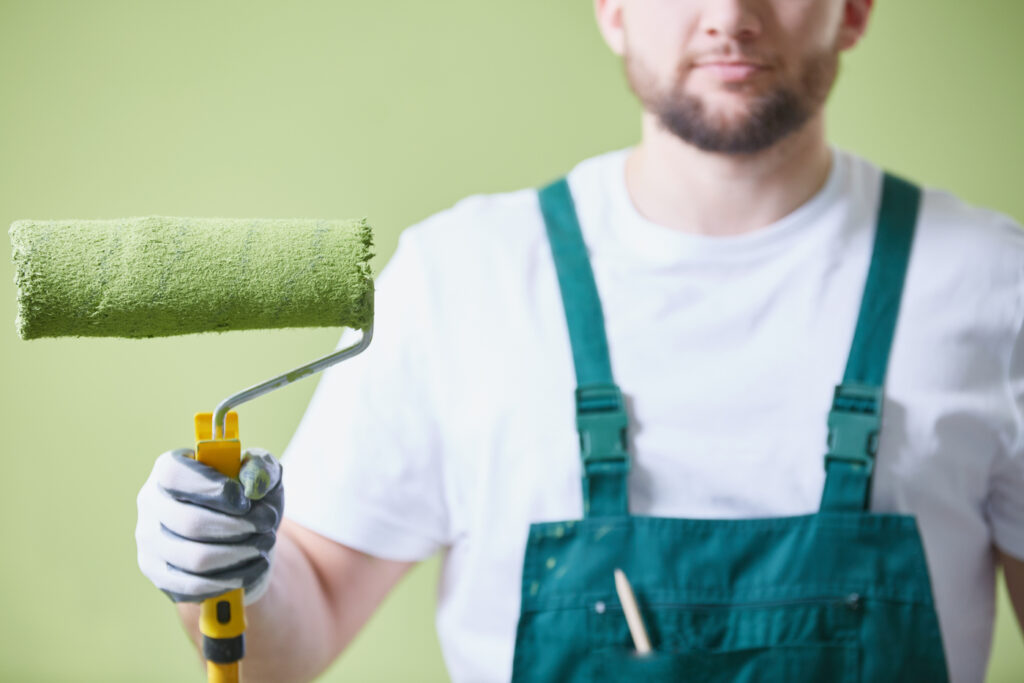Table of Contents
ToggleWe all want our home to be our personal oasis—a haven of comfort, style, and good vibes. From the furniture to the wall decor, every element contributes to the overall ambiance. Yet, there’s one service that has a transformative effect on a home like no other: interior painting services.
The color of your walls can set the mood for the entire room, influencing emotions and even perceptions of space. A change in wall color can make a room feel cozier, brighter, more spacious, or more sophisticated. However, choosing the right color, type of paint, and application method is crucial to getting the desired result. That’s where an interior painting contractor comes into play.
Color psychology in interior painting services
Color isn’t merely an aesthetic choice when it comes to interior design; it serves as a dynamic conduit of emotion, affecting our moods and experiences. This profound impact comes down to color psychology, the study of how colors influence human behavior. It is a crucial tool in an interior painter’s arsenal, allowing them to create spaces that not only look good but feel good.
In understanding how colors affect our emotions, we often categorize them into two distinct types: warm colors and cool colors. Each type sets a different emotional tone and can dramatically shift the feel of a space.
Warm colors, such as reds, oranges, and yellows, are associated with warmth and comfort, akin to a cozy fireplace or a golden sunset. They are reminiscent of sunlight, heat, and natural phenomena that bring about feelings of comfort and happiness.
When incorporated into interior design, such a color palette can make a room feel more intimate and welcoming. They are perfect for social spaces, such as living rooms and dining areas, where interaction and warmth are desired. A red accent wall, for instance, can bring a sense of warmth and vibrancy, stimulating conversation and connection.
On the other hand, cool colors like blues, greens, and purples are associated with calmness and serenity. They remind us of calming elements of nature, such as the tranquility of a clear sky, the soothing calm of a lake, or the peaceful ambiance of a dense forest.
Using these colors in interior design creates a serene and calming environment. They’re perfect for spaces meant for relaxation and peace, like bedrooms and bathrooms. A soft blue wall color can elicit a sense of calm, helping to lower stress and promote restful sleep.
When working with interior painting services to create a certain mood in your home, always remember that balance is key. Overuse of warm colors can lead to feelings of agitation or restlessness, while an excess of cool colors can also create a sense of detachment and can make a room feel chilly or impersonal.
A particularly effective guiding principle to ensure a balance is the 60-30-10 rule. The rule states that 60% of the room should be in the dominant color, which often includes walls, floors, and large pieces of furniture. This color forms the overall unifying theme of the room.
The secondary color should take up 30% of the room, adding depth and interest. This can include smaller furniture pieces, drapes, and linens.
The remaining 10% is the accent color, often applied in decorative accessories like artwork, throw pillows and trinkets. This final touch of color provides the perfect finishing detail that brings the room to life.
By working with interior painting services near you, you can be sure that these color psychology principles will be taken into consideration as they paint your home. But what if you want to Do It Yourself (DIY)? We’ll look at what that takes in the next section.
DIY Painting vs. an Interior Painting Service
Before we dive into a comparison of DIY painting vs. an interior painting service, it is worth discussing the basics of interior painting, beginning with the types of paint. Broadly speaking, there are two categories of paint used in interior painting:
- Water-based paints, also known as latex paints, are the most popular choice for interior walls due to their ease of use, quick drying times, low VOC content, and easy cleanup with soap and water. They also have excellent color retention and are more resistant to fading and yellowing over time.
- Oil-based paints, although more challenging to work with, provide a durable, smooth finish and are less sensitive to environmental conditions during application. They are often chosen for trim, doors, and high-moisture areas.
Next, we have primer, which serves as an undercoat that prepares your wall for the final paint. It helps to hide stains, dark colors, or patches from previous paint jobs, and it ensures better adhesion of paint to the surface, thus increasing durability.
As a general rule, contractors providing interior painting services will use primer when they are painting over new drywall, raw wood, stained/patched areas, or drastically changing wall colors.
Then, we have paint finishes. Paint finish, or sheen, refers to how much light the painted surface reflects. The types of paint finishes are:
- Flat/Matte: This non-reflective finish hides surface imperfections well and offers a rich color effect but can be less durable and harder to clean. It’s a good choice for low-traffic areas like ceilings and adult bedrooms.
- Eggshell/Satin: With a slight sheen, these finishes are more washable and durable than flat paint and work well for high-traffic areas, children’s rooms, hallways, and living rooms.
- Semi-Gloss/Gloss: These finishes are highly resistant to moisture and easy to clean, making them ideal for kitchens, bathrooms, doors, and trim.
Finally, we have the steps to take to paint the interior walls of a home. These are:

- Plan your approach: Before you dive in, think about the final look you want to achieve. Consider painting an accent wall in a bold color or highlighting moldings in a contrasting shade. Also, don’t overlook the ceiling.
- Choose your color: Start by deciding the general color characteristics (Do you want a warm or cool shade? Neutral or saturated?) Get paint samples and test them on the wall at different times of the day. This will give you a better idea of how they look under various lighting conditions.
- Pick out your tools and materials: Be prepared with all the essential tools. This includes paint, a paint roller, an extension pole for the roller, drop cloths, paintbrushes, a paint tray, sandpaper, painter’s tape, rags, and a putty knife.
- Determine how much paint you’ll need: A general rule of thumb is one gallon of paint per 400 square feet. However, it’s wise to use a paint calculator for a more precise estimate. Remember to consider the texture of the surface and the base color.
- Prep the walls and the room: Clear the room or move the furniture to the center and cover it with drop cloths. Apply painter’s tape to the edges, corners, and moldings. Don’t forget to remove the light switch and outlet covers.
- Mix your paint: Consistency is key. Use a wooden paint stick to stir the paint, and make sure to re-stir it frequently throughout the project. If you’re using more than one gallon, mix them in a large bucket to ensure color uniformity.
- Pick your painting techniques: Start from the top and work your way down. Begin with the ceilings, then the walls. Use a brush for the molding and corners and a roller for the larger areas. Apply the paint in long strokes, making a W pattern for even coverage.
- Ensure proper ventilation: Keep the room well-ventilated by opening windows and using fans. This not only ensures your safety but also helps the paint dry faster.
- Clean up: Once you’re done painting, it’s time to clean up. Remove all painter’s tape, gather the drop cloths, and clean the brushes with soapy water or mineral spirits.
- Give yourself enough time: Don’t rush. Budget more time than you think you’ll need. Consider the size of your room, the painting techniques you’re using, and your own experience level. Don’t forget to account for prep and cleanup time.
With all that we now know, let’s compare DIY painting and interior painting services.

- Time: One of the most significant advantages of hiring professional painting contractors is the efficiency they bring. Thanks to their extensive experience and collaborative team effort, they can complete jobs much more quickly than the average DIY enthusiast. On the other hand, DIY painting projects often face unexpected delays due to interruptions or potential inexperience, resulting in a longer-than-anticipated project timeline.
- Cost: At first glance, it may seem that DIY painting projects are cost-effective due to the elimination of labor costs. However, when you factor in the cost of time spent, purchasing tools, and the cost of the paint itself, the expense often becomes comparable to hiring a professional. Professional painters also have the advantage of access to trade discounts on paints and materials, which can help offset the overall cost.
- Workmanship: Professional painters have the training and experience to handle the intricacies of painting—covering different surfaces, avoiding messes, and efficiently finishing tasks. In contrast, DIY enthusiasts might find themselves overwhelmed by these details and end up hiring professionals to rectify mistakes and complete the project, which adds extra cost and time.
- Warranty: Professional painting companies typically offer warranties on their work. This warranty provides peace of mind, knowing that if any issues arise later, they will be handled at no additional cost. However, DIY projects come with their own risks and lack this type of guarantee, which can lead to potential headaches down the line.
- Stress: Whether large or small, painting jobs involve considerable preparation and work. Protecting furniture, preparing surfaces, and cleaning up afterward are all part and parcel of the process. This can be stressful for DIYers managing everything themselves. In contrast, hiring professionals can alleviate these stressors, allowing you to focus on the exciting aspects of your home’s transformation.
While taking on a DIY painting project might seem appealing initially, it’s essential to weigh all factors before diving in. For those who have no prior professional painting experience, hiring a contractor that offers quality interior painting services is the way to go
Contact us here if you would like to find the best interior painting services for your residential needs.
How To Find the Best Interior Painters: Wichita KS
Assuming you are not taking the DIY route and have instead opted to hire the best interior painters, Wichita, KS has lots of painting contractors that you can choose from. But how would you go about choosing the best contractor with the best interior painting services? Here’s a step-by-step guide:
1. Start with research
Begin by searching for interior painting services in your local area. An online search can provide you with a list of potential candidates, but don’t limit yourself to that. Check with local hardware stores, read community message boards, or ask for recommendations from friends, family, or neighbors who’ve had interior painting done recently.
2. Check reviews and ratings
Once you’ve got a list of potential painting services, look for customer reviews on their interior painting service. Websites like Google, Yelp, or the Better Business Bureau can provide insight into previous customers’ experiences. Keep an eye out for comments on the quality of work, professionalism, punctuality, and how the house painters handled any issues that arose during the project.
3. Look for experience and credentials
Experience counts for a lot in painting, so find out how long the company has been in business and what kind of projects they’ve handled. Also, check for any relevant credentials. A licensed, insured, and bonded painter will provide added protection and peace of mind for homeowners.
4. Request quotes and ask the right questions
Once you’ve shortlisted a few promising candidates, request quotes for your project. Be specific about what you want to be done (including preparation, specific rooms or walls, types of paint, etc.) so the estimates are as accurate as possible.
In addition to discussing costs, ask potential painters questions to get a better understanding of their work and process. Here are some questions to consider:
- How will they prepare the surfaces to be painted?
- What type of paint and finish do they recommend and why?
- How many coats of paint will they apply?
- Will they handle the cleanup after the job is finished?
- Can they provide references from previous clients?
5. Compare and decide
After you’ve gathered all the necessary information, it’s time to compare your options. Remember, the cheapest option isn’t necessarily the best. Consider the painter’s experience, reputation, professionalism, and your overall comfort level with them.
A Cost Analysis of Interior Painting Services
Interior painting is far more than just a decorative endeavor—it’s an opportunity to transform your home in meaningful ways. From impacting the mood and perceived size of a room to revamping old furniture or concealing wall imperfections, the power of a fresh coat of paint is undeniable.
That’s why you should also know what to expect in terms of cost when you seek interior painting services for your home:

- Average Cost and What it Includes: Typically, painting the interior of a home costs around $2.75 per square foot. However, when considering walls, trim, and ceilings, the price escalates to $4.69 per square foot. Keep in mind that if pre-painting repairs are required, costs will be higher.
- Impact of Ceiling Height and Access: Higher or lofted ceilings can hike up the painting price by 20%-40%, given the extra time and equipment required. Furthermore, the ease of access to rooms being painted can also affect the cost.
- Regional Variation: Location matters when it comes to painting costs. For instance, a painter in Denver might charge about 10% more than painters in cities like Chicago.
- Cost Determined by Square Footage: The cost per square foot to paint an interior home largely depends on the home’s size and layout, with larger or more complex spaces increasing the price.
- Additional Costs for Tall Walls: Walls higher than 10 feet can augment the cost per square foot by an extra $0.55 – $1.10. For walls extending 14 feet or more in height, this can range from an additional $0.74 – $1.49 per square foot.
- Material Costs: The type of paint you choose significantly influences the overall cost. High-quality paint from premium brands like Sherwin-Williams or Benjamin Moore costs between $50 and $70 per gallon, while lower-grade paint typically falls between $30-$45 per gallon. Paint supplies can add approximately 20% to the paint gallon cost.
- Cost Variations by Room Type: The cost of painting varies depending on the room. Expect to pay between $450 and $700 for bedrooms, $940 to $1,700 for living rooms, $380 to $670 for bathrooms, $450 to $840 for kitchens, and $425 to $850 for dining rooms.
- Seasonal Savings Opportunities: The time of year can affect painting costs. Booking during the off-season, typically winter months, can result in more competitive price quotes.
Whether you’re splashing on a fresh coat of paint or completely transforming your interior decor, a thorough cost analysis will help ensure your project stays within budget.
Remember that the key to a successful home transformation lies not only in the execution but also in thoughtful planning and preparation. We hope this guide empowers you to approach your interior painting project with confidence and excitement as you take one step closer to creating a home that’s a true reflection of your taste and lifestyle.
If you want to learn more about Koehn and our painting services, feel free to get a quote from us.






Recent Comments